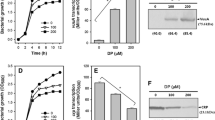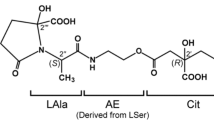Abstract
Vibrio vulnificus, a pathogenic bacterium that causes serious infections in humans, requires iron for growth. Clinical isolate, V. vulnificus M2799, secretes a catecholate siderophore, namely, vulnibactin, to capture iron (III) from the environment. Growth experiments using a deletion mutant indicated that VuuB, a member of the FAD-containing siderophore-interacting protein family, plays a crucial role in Fe3+-vulnibactin reduction. IutB, a member of the ferric-siderophore reductase family, stands a substitute for VuuB in its absence. It remained unclear why V. vulnificus M2799 has two proteins with relevant functions. Here we biochemically characterized VuuB and IutB using purified recombinant proteins. Purified VuuB, a flavoprotein, catalyzed the reduction of Fe3+-nitrilotriacetic acid as its electron acceptor, in the presence of NADH as its electron donor and FAD as its cofactor. IutB catalyzed the reduction of Fe3+-nitrilotriacetic acid, in the presence of NADH, NADPH, or reduced glutathione as its electron donor. The optimal pH values and temperatures of VuuB and IutB were 7.0 and 37 °C, and 8.5 and 45 °C, respectively. On analyzing their ferric-chelate reductase activities, both VuuB and IutB were found to catalyze the reduction of Fe3+-aerobactin, Fe3+-vibriobactin, and Fe3+-vulnibactin. When the biologically relevant substrate, Fe3+-vulnibactin, was used, the levels of ferric-chelate reductase activities were similar between VuuB and IutB. Finally, the mRNA levels were quantified by qRT-PCR in M2799 cells cultivated under low-iron conditions. The number of vuuB mRNA was 8.5 times greater than that of iutB. The expression ratio correlated with the growth of their mutants in the presence of vulnibactin.









Similar content being viewed by others
References
Boukhalfa H, Crumbliss AL (2002) Chemical aspects of siderophore mediated iron transport. Biometals 15:325–339
Bradford M (1976) A rapid and sensitive method for the quantitation of microgram qualities of protein utilizing the principle of protein-dye binding. Anal Biochem 72:248–254
Butterton JR, Calderwood SB (1994) Identification, cloning, and sequencing of a gene required for ferric vibriobactin utilization by Vibrio cholerae. J Bacteriol 176:5631–5638
Byers B, Arceneaux J (1998) Microbial iron transport: iron acquisition by pathogenic microorganisms. Met Ions Biol Syst 35:37–66
Cox CD (1980) Iron reductases from Pseudomonas aeruginosa. J Bacteriol 141:199–204
Datta S, Crosa JH (2012) Identification and characterization of a novel outer membrane protein receptor required for hemin utilization in Vibrio vulnificus. Biometals 25:275–283
Griffiths GL, Sigel SP, Payne SM, Neilands JB (1984) Vibriobactin, a siderophore from Vibrio cholerae. J Biol Chem 259:383–385
Hantke K (2001) Iron and metal regulation in bacteria. Curr Opin Microbiol 4:172–177
Kawano H, Miyamoto K, Negoro M et al (2017) IutB participates in the ferric-vulnibactin utilization system in Vibrio vulnificus M2799. Biometals 30:203–216
Kawano H, Miyamoto K, Sakaguchi I et al (2013) Role of periplasmic binding proteins, FatB and VatD, in the vulnibactin utilization system of Vibrio vulnificus M2799. Microb Pathog 65:73–81
Kawano H, Miyamoto K, Yasunobe M et al (2014) The RND protein is involved in the vulnibactin export system in Vibrio vulnificus M2799. Microb Pathog 75:59–67
Khan A, Singh P, Srivastava A (2018) Synthesis, nature and utility of universal iron chelator—Siderophore: a review. Microbiol Res 212–213:103–111
Kim C-M, Park R-Y, Park J-H et al (2006) Vibrio vulnificus vulnibactin, but not metalloprotease VvpE, is essentially required for iron-uptake from human holotransferrin. Biol Pharm Bull 29:911–918
Kim YR, Lee SE, Kook H et al (2008) Vibrio vulnificus RTX toxin kills host cells only after contact of the bacteria with host cells. Cell Microbiol 10:848–862
Kothary MH, Kreger AS (1987) Purification and characterization of an elastolytic protease of Vibrio vulnificus. J Gen Microbiol 133:1783–1791
Kwak JS, Jeong H-G, Satchell KJF (2011) Vibrio vulnificus rtxA1 gene recombination generates toxin variants with altered potency during intestinal infection. Proc Natl Acad Sci USA 108:1645–1650
Laemmli UK (1970) Cleavage of structural proteins during the assembly of the head of bacteriophage T4. Nature 227:680–685
Li K, Chen WH, Bruner SD (2015) Structure and mechanism of the siderophore-interacting protein from the fuscachelin gene cluster of Thermobifida fusca. Biochemistry 54:3989–4000
Litwin CM, Byrne BL (1998) Cloning and characterization of an outer membrane protein of Vibrio vulnificus required for heme utilization: regulation of expression and determination of the gene sequence. Infect Immun 66:3134–3141
Litwin CM, Calderwood SB (1993) Cloning and genetic analysis of the Vibrio vulnificus fur gene and construction of a fur mutant by in vivo marker exchange. J Bacteriol 175:706–715
Litwin CM, Rayback TW, Skinner J (1996) Role of catechol siderophore synthesis in Vibrio vulnificus virulence. Infect Immun 64:2834–2838
Matzanke BF, Anemüller S, Schünemann V et al (2004) FhuF, part of a siderophore-reductase system. Biochemistry 43:1386–1392
McKie AT, Barrow D, Latunde-Dada GO et al (2001) An iron-regulated ferric reductase associated with the absorption of dietary iron. Science 291:1755–1759
Miethke M, Hou J, Marahiel MA (2011) The siderophore-interacting protein YqjH acts as a ferric reductase in different iron assimilation pathways of Escherichia coli. Biochemistry 50:10951–10964
Miyamoto K, Kosakai K, Ikebayashi S et al (2009) Proteomic analysis of Vibrio vulnificus M2799 grown under iron-repleted and iron-depleted conditions. Microb Pathog 46:171–177
Miyoshi N, Shimizu C, Miyoshi S, Shinoda S (1987) Purification and characterization of Vibrio vulnificus protease. Microbiol Immunol 31:13–25
Oh MH, Lee SM, Lee DH, Choi SH (2009) Regulation of the Vibrio vulnificus hupA gene by temperature alteration and cyclic AMP receptor protein and evaluation of its role in virulence. Infect Immun 77:1208–1215
Okujo N, Saito M, Yamamoto S et al (1994) Structure of vulnibactin, a new polyamine-containing siderophore from Vibrio vulnificus. Biometals 7:109–116
Oliver JD (2015) The Biology of Vibrio vulnificus. Microbiol Spectr 3: VE-0001–2014
Poch MT, Johnson W (1993) Ferric reductases of Legionella pneumophila. Biometals 6:107–114
Ratledge C, Dover LG (2000) Iron metabolism in pathogenic bacteria. Annu Rev Microbiol 54:881–941
Raymond KN, Dertz EA, Kim SS (2003) Enterobactin: an archetype for microbial iron transport. Proc Natl Acad Sci USA 100:3584–3588
Saha M, Sarkar S, Sarkar B et al (2016) Microbial siderophores and their potential applications: a review. Environ Sci Pollut Res 23:3984–3999
Schröder I, Johnson E, De Vries S (2003) Microbial ferric iron reductases. FEMS Microbiol Rev 27:427–447
Simpson LM, White VK, Zane SF, Oliver JD (1987) Correlation between virulence and colony morphology in Vibrio vulnificus. Infect Immun 55:269–272
Tacket CO, Brenner F, Blake PA (1984) Clinical features and an epidemiological study of Vibrio vulnificus infections. J Infect Dis 149:558–561
Tan W, Verma V, Jeong K et al (2014) Molecular characterization of vulnibactin biosynthesis in Vibrio vulnificus indicates the existence of an alternative siderophore. Front Microbiol 5:1–11
Tanabe T, Naka A, Aso H et al (2005a) A novel aerobactin utilization cluster in Vibrio vulnificus with a gene involved in the transcription regulation of the iutA homologue. Microbiol Immunol 49:823–834
Tanabe T, Takata N, Naka A et al (2005b) Identification of an AraC-like regulator gene required for induction of the 78-kDa ferrioxamine B receptor in Vibrio vulnificus. FEMS Microbiol Lett 249:309–314
Timmerman MM, Woods JP (1999) Ferric reduction is a potential iron acquisition mechanism for Histoplasma capsulatum. Infect Immun 67:6403–6408
Trindade IB, Silva JM, Fonseca BM et al (2019) Structure and reactivity of a siderophore-interacting protein from the marine bacterium Shewanella reveals unanticipated functional versatility. J Biol Chem 294:157–167
Tsuchiya T, Mitsuo E, Hayashi N et al (2007) Vibrio vulnificus damages macrophages during the early phase of infection. Infect Immun 75:4592–4596
Vadas A, Monbouquette HG, Johnson E, Schröder I (1999) Identification and characterization of a novel ferric reductase from the hyperthermophilic Archaeon Archaeoglobus fulgidus. J Biol Chem 274:36715–36721
Wang S, Wu Y, Outten FW (2011) Fur and the novel regulator yqjI control transcription of the ferric reductase gene yqjH in Escherichia coli. J Bacteriol 193:563–574
Webster ACD, Litwin CM (2000) Cloning and characterization of vuuA, a gene encoding the Vibrio vulnificus ferric vulnibactin receptor. Infect Immun 68:526–534
Wyckoff EE, Allred BE, Raymond KN, Payne SM (2015) Catechol siderophore transport by Vibrio cholerae. J Bacteriol 197:2840–2849
Acknowledgements
This study was supported in part by a Grant-in-Aid for the Strategic Research Foundation Grant-aided Project for Private Universities from the Ministry of Education, Culture, Sports, Science and Technology (MEXT), Japan, 2011–2015 (S1101031). We thank Prof. Shin-ichi Miyoshi for supplying the V. vulnificus clinical isolate strain M2799. We are grateful for helpful advice provided by Prof. Seiji Inoue, Prof. Rikiro Fukunaga, Dr Shinobu Fujii, Dr Takaji Sato, Dr Yasuko In, Dr Katsuhiko Minoura, and Dr Toshihiro Fujii at Osaka University of Pharmaceutical Sciences. We also thank Kate Fox, DPhil, from Edanz Group (www.edanzediting.com/ac) for editing a draft of this manuscript.
Author information
Authors and Affiliations
Corresponding author
Additional information
Publisher's Note
Springer Nature remains neutral with regard to jurisdictional claims in published maps and institutional affiliations.
Rights and permissions
About this article
Cite this article
Okai, N., Miyamoto, K., Tomoo, K. et al. VuuB and IutB reduce ferric-vulnibactin in Vibrio vulnificus M2799. Biometals 33, 187–200 (2020). https://doi.org/10.1007/s10534-020-00241-5
Received:
Accepted:
Published:
Issue Date:
DOI: https://doi.org/10.1007/s10534-020-00241-5




